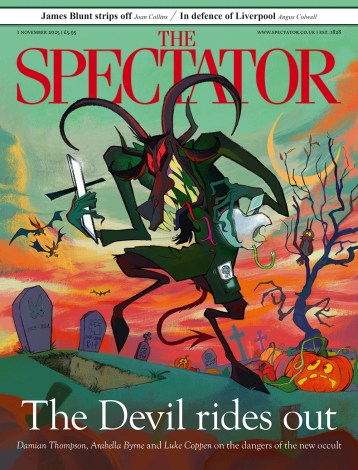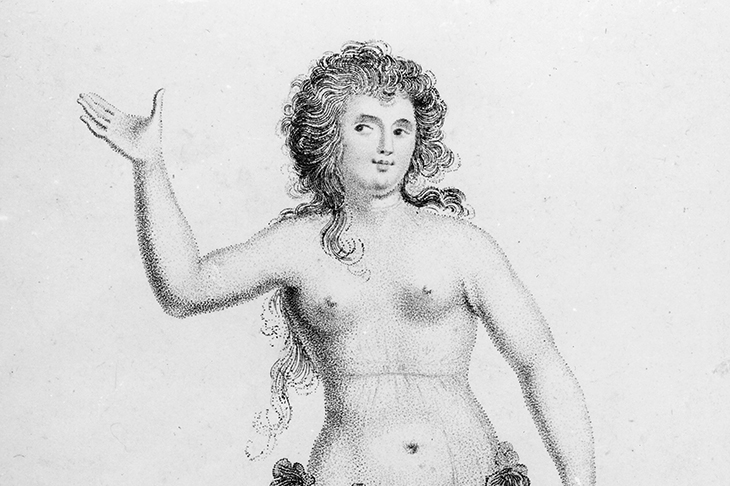At the masquerade celebrating the end of the War of Austrian Succession no one could take their eyes off the beautiful Elizabeth Chudleigh. She had come, she said, as ‘Iphigenia, ready for the sacrifice’, and it was what she was wearing — or to all appearances not wearing — that caused a sensation that lasted for months. In the candlelight, her clinging costume of flesh-coloured silk made her appear completely naked; ‘a perfect review of the unadorned mother of mankind’, said one account.
The furore caused by this episode was only eclipsed when, 27 years later, Elizabeth, now the widowed Duchess of Kingston, was put on trial for bigamy. The case had to be twice postponed in order to increase the number of seats for the would-be audience; and the American War of Independence then taking place was quite forgotten as the beau monde struggled to obtain tickets for the hearing.
The case, and what led up to it, is at the heart of Catherine Ostler’s well written and researched book. There are many, many characters — a cast list of almost 100 — and occasionally the thrust of the story is lost in detail. Having said that, it is a gripping tale.
The newlyweds agreed to keep their marriage a secret, and both behaved as though they were still single
Elizabeth’s career in the public eye had begun when, at 22, she became a maid of honour to Princess Augusta, the wife of the heir to the British throne. It was a post that carried with it the title ‘the Hon.’, a salary and the chance of an advantageous marriage. But while staying in Hampshire with a widowed cousin, chaperoned by her aunt Ann Hamner, Elizabeth met the 20-year-old Augustus Hervey, an impecunious young naval officer but already a practised seducer who was also the grandson of the Earl of Bristol.
They were instantly attracted to one another and they impetuously married at 11 o’clock one August night in 1744, the local vicar having been called out of bed to perform the ceremony. Apart from two family members, the only other person present was Mrs Hamner’s maid, Ann Craddock. The newlyweds agreed to keep the marriage a secret, so that Elizabeth could retain her position at court (maids of honour had to be single), and Hervey could avoid the risk of alienating his family, who would have been furious at such a youthful marriage to a penniless girl. Almost at once, his ship sailed for the West Indies.
From then on, the story weaves between the court, Elizabeth’s admirers, Hervey’s rising naval fortunes and numerous love affairs, the political background, the secret birth of Elizabeth’s child by Hervey (who died within a few months), her property ventures and the excessive spending of both. Rumours of the clandestine marriage leaked out, aided by gossip, speculation and the odd indiscretion by Elizabeth; but none of this affected either of the Herveys’ lives. Both behaved in fact as though they were still single.
The catalyst was the arrival of the rich, handsome and charming Duke of Kingston, who had returned from a long European tour with a French mistress in tow but who quickly fell for Elizabeth, and she for him. What to do? For Elizabeth, divorce was hardly an option: it required an Act of Parliament, was hugely expensive and was almost always brought by the man, because while male infidelity did not count as a reason for divorce, female adultery did.
Eventually Hervey, anxious to marry another, wanted a divorce. By appealing to his sense of honour, Elizabeth persuaded him not to use adultery as the cause (was it really the act of a gentleman to hold up to shame the name of a woman he had once loved?) but instead to sue in the ecclesiastical courts, an altogether gentler affair. But for these to grant a divorce, it was necessary first to prove that there had actually been a marriage. And as Elizabeth had always maintained that she was single, the onus was on Hervey to do so.
Unfortunately for Hervey, as far as he knew the few witnesses were dead; nor, to his knowledge, had the marriage been registered. With no evidence of a marriage, the ecclesiastical courts had to rule Elizabeth a single woman — whereupon she promptly married her duke.
There was fury and jealousy all round, especially from the duke’s sister and her family, who stood to inherit his estates if he died unmarried, as had seemed likely. When he did die, in 1773, they pounced, bringing a suit for bigamy: Elizabeth, they said, was really the Countess of Bristol (Hervey had succeeded to the earldom two years earlier), so had never been truly married to the duke— and therefore his will must be invalid.
There followed a swirl of claim, counter-claim, sudden discovery of the only living witness and a general unravelling of Elizabeth’s story. She remained flamboyant and unrepentant, travelling abroad with great éclat, spending as freely as ever — and the subject of scandal for the rest of her life. For, as the Times commented: ‘Bigamy, it seems, is a greater crime than simple fornication or fashionable adultery.’






Comments